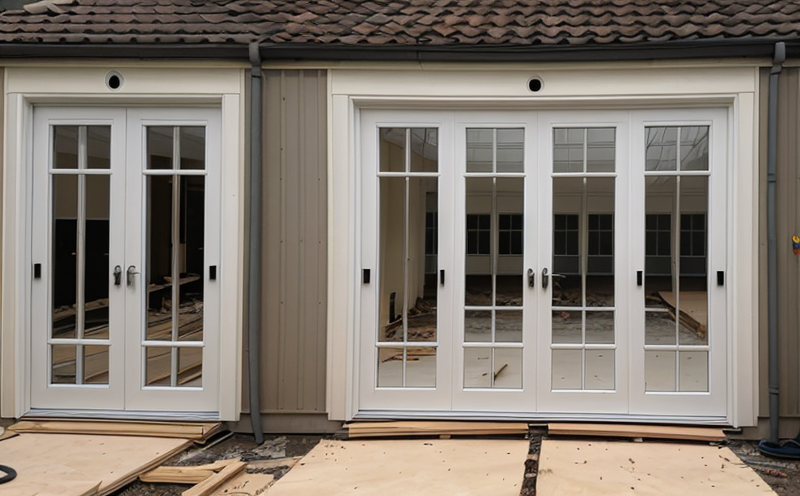Fire Resistance Assessment of Fire-Exit Routes
Ensuring the safe evacuation of building occupants during emergencies is paramount in fire safety design. Fire-resistant doors, windows, and partitions are critical components that contribute to this goal by providing a barrier against flames and smoke. The fire resistance assessment of fire-exit routes involves evaluating these critical elements to ensure they meet regulatory standards and operational requirements.
The process begins with the selection of appropriate specimens for testing. Fire-exit doors, windows, and partitions are typically subjected to controlled laboratory fires where their ability to withstand heat and prevent smoke from passing through is assessed. This may involve simulating real-world conditions such as exposure to temperatures up to 1000°C (1832°F) or higher, depending on the specific standard being adhered to.
During the test, various parameters are closely monitored including temperature rise within the compartment, smoke and gas leakage rates, structural integrity of the specimen, and the extent of any flame spread. Compliance with standards such as ISO 15610-2, EN 301 789, ASTM E1469, or IEC 60332 is crucial to ensure that fire-exit routes are reliable in actual emergency situations.
The testing apparatus used includes specialized chambers designed to simulate the environment a fire-exit route might encounter. These chambers can be pressurized with air and controlled for temperature, which allows for accurate reproduction of real-world conditions. The results of these tests provide critical data that helps design teams refine their products further.
Once testing is complete, comprehensive reports are generated detailing the performance of each specimen under test conditions. These reports serve as valuable tools for architects, engineers, and building owners in making informed decisions about product selection and installation. They also play a key role in ensuring compliance with local codes and regulations.
The importance of fire-exit routes cannot be overstated; they are lifelines during emergencies and must function flawlessly when needed most. By investing in thorough fire resistance assessments, organizations can significantly enhance the safety of their buildings and contribute to public welfare.
Benefits
- Enhanced Safety: Ensures that fire-exit routes meet stringent standards, thereby enhancing occupant safety during emergencies.
- Compliance Assurance: Provides the necessary documentation to demonstrate compliance with relevant international and national codes.
- Improved Reputation: Demonstrates a commitment to quality and safety, which can enhance your organization’s reputation.
- Cost Savings: Early identification of issues through testing can prevent costly rework or failures during installation.
- Increased Confidence: Reliable fire-exit routes instill confidence in building occupants and stakeholders alike.
Industry Applications
The fire resistance assessment of fire-exit routes is applicable across numerous sectors including commercial buildings, residential complexes, schools, hospitals, and public venues. In these settings, ensuring the integrity of fire-exit routes can mean the difference between life and death in an emergency.
For example, a hospital might require testing to ensure that its fire-exit doors meet the stringent demands of ISO 15610-2, which ensures that the door can withstand exposure to high temperatures for extended periods without compromising structural integrity or allowing smoke to pass through. Similarly, in commercial settings like shopping malls, windows and partitions need to be tested against IEC 60332 standards to ensure they meet flame retardancy requirements.
These assessments are not just a regulatory requirement but also an essential part of ensuring that buildings are safe environments for occupants. They provide peace of mind knowing that critical safety features have been rigorously evaluated and certified.
Why Choose This Test
The fire resistance assessment of fire-exit routes is a crucial step in ensuring the safety and integrity of these vital components. By choosing this test, you are taking proactive steps to comply with stringent standards that have been developed by recognized bodies like ISO, ASTM, EN, and IEC.
One of the main reasons for selecting this service is the ability to identify potential weaknesses or areas for improvement before installation. This early detection can save significant costs in terms of both time and money. Additionally, it provides confidence that your fire-exit routes will perform as expected when subjected to real-world conditions.
Another key benefit is the peace of mind provided by knowing that you are meeting all necessary regulatory requirements. This not only protects your organization from potential legal issues but also enhances its reputation among stakeholders and customers alike.
The test offers a comprehensive approach, covering every aspect of fire resistance including thermal insulation, structural integrity, smoke control, and flame spread. This holistic assessment ensures that no detail is overlooked, providing you with robust evidence that your fire-exit routes are up to the task in any emergency scenario.





